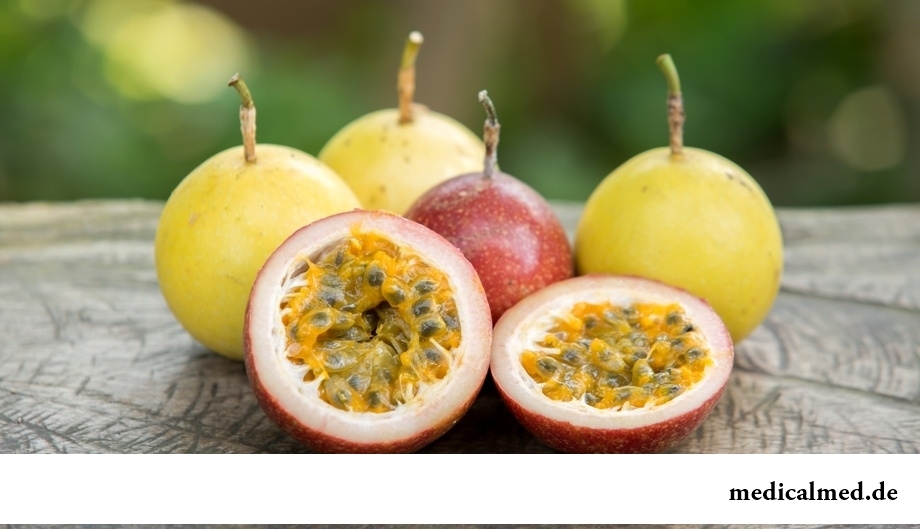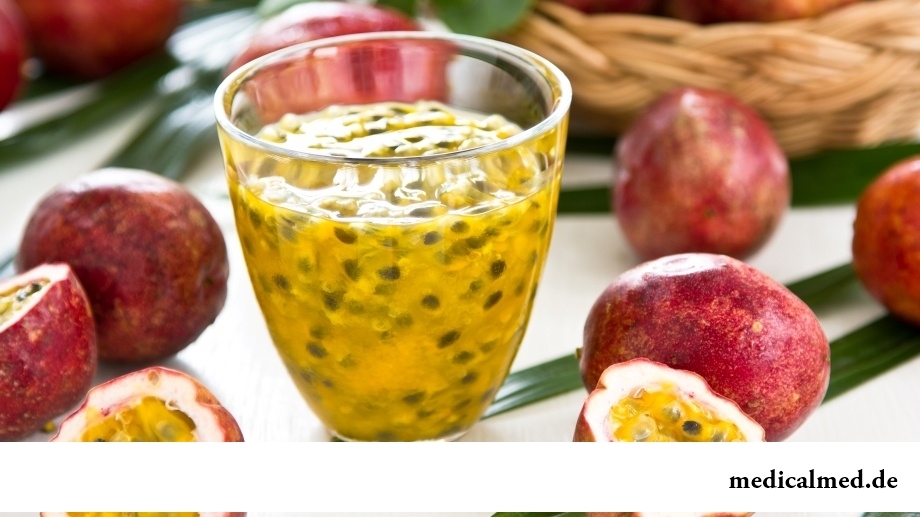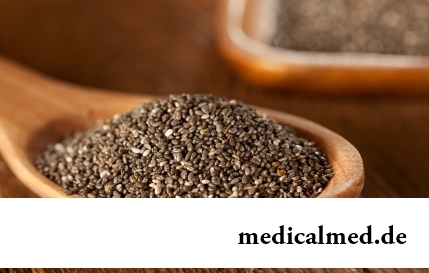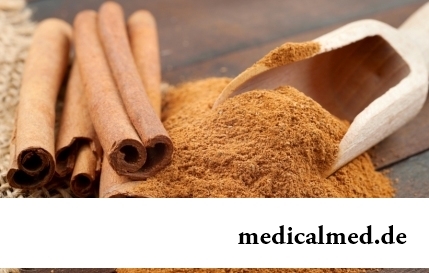





Passion fruit
Description of passion fruit
The passion fruit known also as the Passionflower edible, Granadilla purple or the Passionflower edible, belongs to perennial plants from the sort Passiflora.

The homeland of passion fruit are subtropical wild regions of South America, most likely Paraguay. Now the passionflower is grown up in the majority of the countries of Central and South America, and also in New Zealand, Australia, in Hawaii and in South Africa.
There are more than 400 grades of passion fruit which differ by the size, a form, a coloring and tastes of fruits, the majority of which are edible.
Passion fruit – extraordinary beautiful climber which, like grapes, in a growth period releases short moustaches and twists everything that meets on its way. The passionflower blossoms in greenish-white fragrant colors. Average life expectancy of a plant makes 5-7 years.
Fruits of passion fruit have a smooth wax surface and the oval form in the diameter from 4 to 8 centimeters (like a lemon). Average weight makes about 35-50 g.
Two main types of a passionflower – with violet and yellow fruit are now cultivated. Yellow fruits, as a rule, it is more, than violet, also grow to the grapefruit sizes. However pulp of violet fruits more juicy and sweet also has more richly aroma and taste. In fruits the membrane bags containing fleshy juice with numerous small seeds without stones are located.
Structure of passion fruit
Useful properties of passion fruit are caused by its chemical composition. So, in 100 g of fruits contains:
- 78 g of water;
- 2,4 g of proteins;
- 0,4 g of fats;
- 13,4 g of carbohydrates;
- 1,5 g of cellulose.
Besides, fruits are vitamin-rich among which is most of all ascorbic acid and RR vitamin (24 and 2,5 mg respectively in 100 g of fruits). Passion fruit contains also other vitamins, namely vitamins A, B1, B6, B5, B2, E, N and To.
Fruits of passion fruit can be carried to a number of the fruit containing the potassium playing a large role in work of cardiovascular system in a large number (340 mg in 100 g of fruits). Passion fruit contains also other macrocells, namely: calcium, sodium, sulfur, chlorine, phosphorus and magnesium.
From the microelements which are contained in passionflower fruits, most of all iron and zinc (1,3 and 0,25 mg respectively in 100 g), and also in small amounts there is an iodine, manganese, copper, fluorine and some other.
In 100 g of fruits of passion fruit about 68 kcal contain on average.
Useful properties of passion fruit
Thanks to the balanced mineral composition and high content of potassium, dietitians recommend to eat passion fruit fruits at diseases of a liver, cardiovascular system and urinary tract. Also thanks to the low caloric content and high nutrition value they advise to use this fruit for weight reduction.
Passion fruit has febrifugal, antimicrobic and laxative properties. Ability to improve work of the alimentary system, to reduce cholesterol level in blood and to bring toxins, uric acid and other products of exchange out of an organism belongs to other useful properties of passion fruit.
Pulp of passion fruit is a source of food fibers which content in some grades reaches 27%. Cellulose provides removal of cholesterol from an organism, and also protection of a mucous membrane of a large intestine.
A large amount of the vitamin C which is contained in passion fruit promotes strengthening of immunity against flu and other infectious diseases. Vitamin A and flavonoids are necessary for preservation of good sight and good nutrition of mucous membranes and skin.
Juice of passion fruit has the calming property, helps to take off fatigue and improves quality of a dream. Some researches claim that juice of passion fruit suppresses growth of cancer cells. Seeds of fruits are an important source of protein.
Passion fruit oil
Aromatic oil of passion fruit contains olein (to 20%), linoleic (to 80%), stearin (to 5%) and palmitic (to 15%) acids, and also saponins, amino acids, lemon and ascorbic acids, pectin, alkaloids, starch and potassium.
Passion fruit oil when drawing on skin leaves a pellicle which on the one hand interferes with moisture loss, and with another – allows skin to breathe. The vitamins-antioxidants which are a part of oil prevent a senilism of skin and protect it from negative impact of external factors. Carry to other useful properties of oil of passion fruit:
- Stimulation of local blood circulation;
- Recovery of a protective lipidic layer and elasticity of skin;
- Salutary impact on the inflamed and angry skin.
Oil of passion fruit is applied in cosmetology to production:
- Massage oils;
- The moisturizing and regenerating creams;
- Creams, gels, masks for age, dry, fat and problem skin;
- Shower gels;
- Oil and creams for care of skin after suntan;
- Shampoos and conditioners for any type of hair;
- Oils for split ends of hair;
- Medical creams at eczema, peelings and psoriasis.
Use of passion fruit
In Caribbean countries in the medical purposes all parts of passion fruit are widely used:
1. The leaves containing alkaloids use for gradual lowering of blood pressure;
2. Flowers apply as sedative and an antispasmodic;
3. Fruits use as the accompanying therapy at treatment of nervous breakdowns, bronchitis, asthmas, arthritis, sleeplessness, gastrointestinal frustration and symptoms of a menopause.
Only ripe fruits of passion fruit are eaten. Usually they are eaten in the raw, cutting in half and eating away pulp a spoon. After storage within several days in the warm place the content of saccharites in fruits increases.
In the different countries there were various culinary traditions of use of passion fruit:
- Brazil prepares mousses and juice from pulp of fruits, and it is accepted to decorate with seeds pastries;
- On Philippines and Hawaii passion fruit fruits, as a rule, do not cut, and puncture then pulp as from a coco, drink through a tubule;
- In the countries of Latin America fruits are traditionally eaten with a lime and red pepper;
- Passion fruit syrup in Dominican Republic can be given with fruit ice, and fruits – are with sugar;
- The dessert from plant fruits with honey is a popular dish in Vietnam;
- In Australia from passion fruit traditionally cook sweet sauces and eat them with desserts for breakfast.

How to choose and keep passion fruit fruits
Fruits of passion fruit should be chosen well ripened and heavy for the size. Fruits with slightly wrinkled thin skin, as a rule, more sweet and tasty, and insignificant cuts and spots do not influence their quality.
It is necessary to store fruits in the dark cool place, as a rule, no more than one week. To keep a passionflower longer, it is strewed most often with a small amount of sugar and frozen.
Contraindications
The use of fruits of passion fruit is not recommended to the people having tendency to allergic reactions and also at individual intolerance of this fruit.
Even if heart of the person does not fight, then he all the same can live during a long period, as the Norwegian fisherman Jan Revsdal showed us. Its "motor" stopped for 4 hours after the fisherman got lost and fell asleep in snow.

It would seem, to buy drugs in Moscow does not make a problem – a drugstore, and not one, is available for each resident of the capital in step a toast...
Section: Articles about health
History of mankind contains several tens of epidemics whose emergence was compared by eyewitnesses and historians to doomsday. The most terrible of them claimed the lives of millions of people, having made even the whole people to the person of the earth. What they − the diseases striking terror? Daringly...
Section: Articles about health
The chia plant, or the Spanish sage, is from South America. The indigenous people of the continent since ancient times used its seeds in food: small, but very nutritious kernels, in a form the reminding fasolina. Indians knew about useful properties of seeds of a chia, and applied them to maintenance of vitality and increase in endurance before serious exercise stresses....
Section: Articles about health
The drugs stopping or oppressing life activity of pathogenic microorganisms are widely applied in clinical practice with 4...
Section: Articles about health
Cystitis, or inflammation of a mucous membrane of a bladder, this very widespread disease which, owing to some features of a structure of bodies of urinogenital system, women have approximately four times more often than men. In the main risk group...
Section: Articles about health
More than a half of the married couples which faced prostatitis – leave. The new broadcast "Female View of Prostatitis" will help to learn – whether you have or your relatives problems....
Section: Articles about health
You are office worker, the driver, the fan of winter sports or do not think of life without bicycle? You conduct a slow-moving image жизн...
Section: Articles about health
Ayurveda - the most ancient tselitelsky practice which came to us from India. It represents the doctrine about maintenance of physical, psychological and moral health of the person by means of the complex of procedures including a diet, cleaning of an organism, respiratory упр...
Section: Articles about health
Modern footwear is extremely various. It stopped being only protection for legs long ago. Today shoes, boots, barefoot persons choose not so much proceeding from their convenience and functionality how many being guided by outward, brand and an opportunity to add with them a stylish dress. At the same time, buying footwear, think of its safety a little. Meanwhile, many popular models can do essential harm to health....
Section: Articles about health
For many women the word "fat" sounds as a sentence. In aspiration to an ideal figure they try to exclude, first of all, from with...
Section: Articles about health
Health and attractiveness - eternal values, pursuing which people often use the most unusual ingredients and technicians. Let's consider 11 most exotic and sometimes not most pleasant Spa procedures to which the person in a pursuit for beauty agrees...
Section: Articles about health
Many of us, probably, noticed more than once that from intellectual loadings at some point the brain as though "overheats" and "assimilation" of information is strongly slowed down. Especially this problem urgent for persons of age becomes more senior than fifty years. "Already badly I think", "the head will burst now", "memory as if is disconnected" - here that wants to be told at the time of information overload....
Section: Articles about health
The saying "the rich do not know how the other half lives" is known to all. In a broad sense it is that we can not always understand the person, about...
Section: Articles about health
The main role in development of a peptic ulcer of a stomach and duodenum the bacterium Helikobakter plays pilor. Activity and the strengthened reproduction of this microorganism lead to weakening of protection of mucous membranes and their erosive damage. Manifestations not...
Section: Articles about health
Eyes – unique body on the structure thanks to which the person obtains about 80% of information on the world around: about a form, color, size, the movement, and also many other parameters of objects or phenomena. But whether much we know about the most valuable sense body which, according to the scientist Sechenov, provides us about one thousand various feelings a minute? Let's consider 10 most surprising facts about eyes and sight....
Section: Articles about health
The pine is one of the most widespread plants of our woods. Its needles and pitch not without reason called by "gallipot", since ancient times испол...
Section: Articles about health
Partial and the more so full loss of hearing significantly reduces quality of life. Difficulties with communication lead to loneliness and isolation. The person who badly hears experiences difficulties with social and professional implementation, quite often has problems in...
Section: Articles about health
For many spouses the question of planning of a family is one of the main. The problem of the choice of effective and safe contraceptives at the same time comes out on top. Russians still not often resort to operation of a vasectomy extremely popular in the USA, and also in some European and Asian countries. The reason is simple: most of men simply do not possess the complete information about specifics and effects of this procedure. Let's try to meet this lack and to acquaint readers about those...
Section: Articles about health
There is an opinion that at low temperatures safety of products is ensured longer and better thanks to what the refrigerator considers...
Section: Articles about health
Neurosis is called pathology of a nervous system at which deviations in functioning of the highest nervous processes are observed. Most often - owing to yet not strengthened mentality - children are subject to neurosises. Premises to emergence of such disturbances can become нез...
Section: Articles about health
Weakness of an ankle joint – very widespread problem. Its existence is demonstrated by tendency to a podvorachivaniye of legs when walking on heels, frequent painful sprains, pain on average and anonymous toes even after small loadings. Usually people with such pathology take off unpleasant effects by means of the anesthetizing pulverizing and ointments, but it does not lead to radical elimination of a problem. Meanwhile, at the known persistence it is possible to strengthen an ankle to the house...
Section: Articles about health
Small appetite at the child – the complaint which pediatricians should hear practically from each mother. Most often it is carried to разр...
Section: Articles about health
New year, wedding, birthday, office party – an occasion to drink at the Russian person will always be. How to reduce a negative impact of alcohol by an organism and to avoid a condition of strong intoxication? The most correct council – to refuse the use spirits напитк...
Section: Articles about health
Proofs of efficiency of Mildronate at treatment of coronary heart disease with stenocardia can be found in many publications of the end of the twentieth century. Researches were conducted since 1984, including placebo - controlled effects. In total clinical tests of Mildronate were carried out for more than thirty years....
Section: Articles about health
Each failure in work of bodies and systems of a human body is, as a rule, shown by the whole complex of symptoms. In particular, N...
Section: Articles about health
Maternal milk is the best food for the newborn. It is the unique natural product containing an optimum set of nutrients, and which is best adapted in order that the baby normally developed and it was protected from harmful fa...
Section: Articles about health
A lot of things depend on a condition of a backbone in a human body, a backbone - not only a support for a body, it also a receptacle for a spinal cord, that is why malfunctions with a backbone are so dangerous. To treat rachis diseases very difficult and long, it is much simpler and more correct not to bring to a disease. Conforming to the rules provided in this article it is possible to avoid the majority of the problems connected with a backbone including those which are considered to be age, but a cat...
Section: Articles about health
